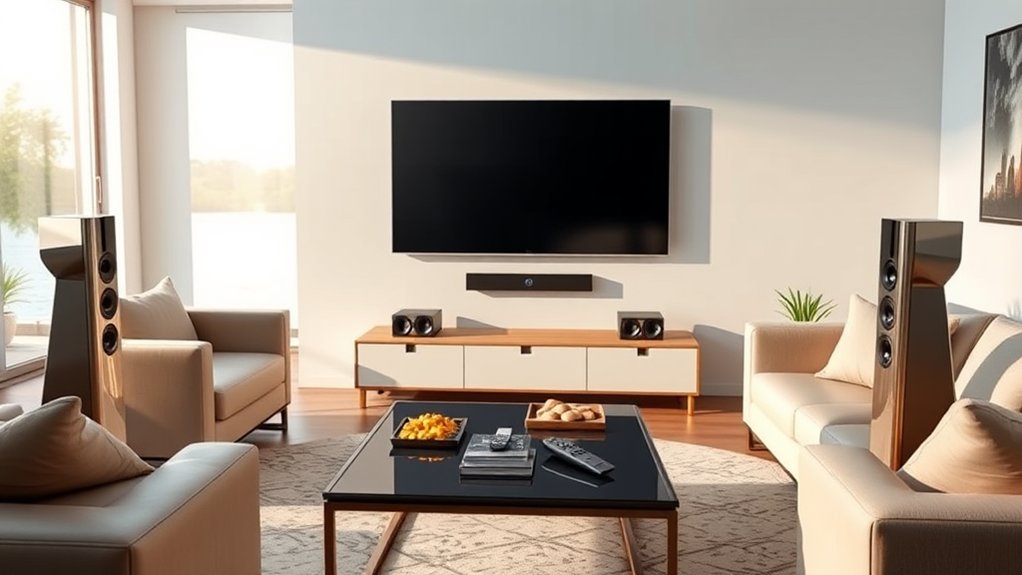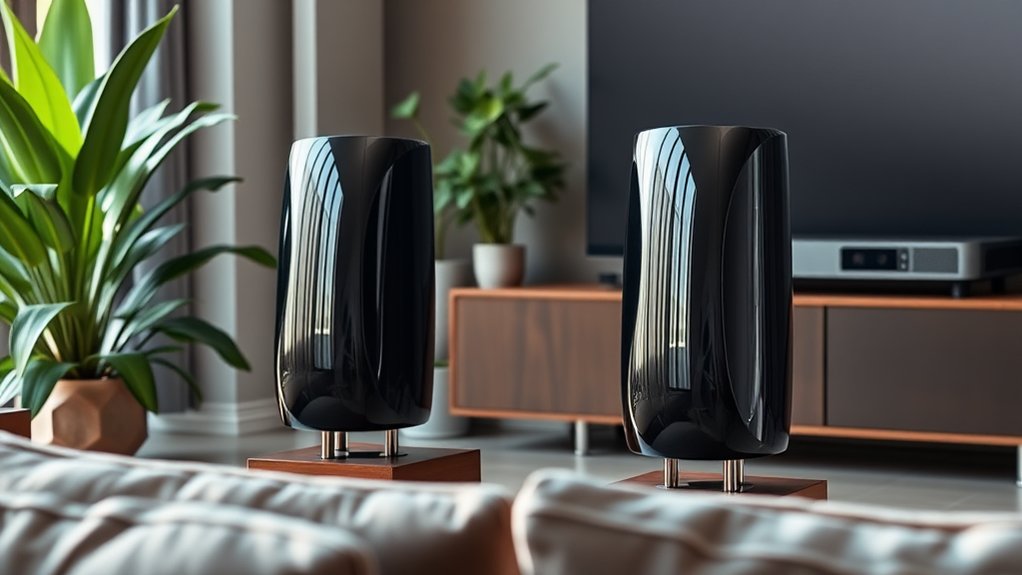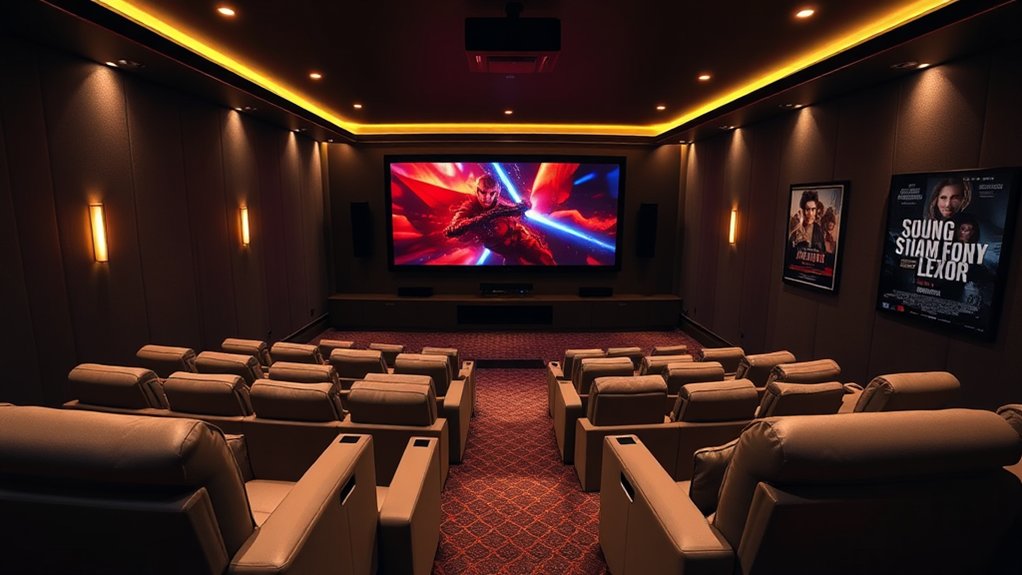When choosing floor standing home theater speakers, start by setting a realistic budget that considers sound quality and speaker size. Next, assess your room’s compatibility; speakers need space to shine. Don’t forget to prioritize features like frequency response for deep bass, and check the build quality—dense materials mean clearer sound. Confirm your amplifier matches the speakers’ power ratings for peak performance. Curious about placement tips or how to improve your setup? Stick around for more insights!
Key Highlights
- Set a budget that balances cost and sound quality; remember cheaper options may lack depth and clarity.
- Choose speaker size based on your room dimensions to avoid poor sound performance; ideally, use speakers suited for around 20 x 14 feet rooms.
- Evaluate sound performance by focusing on frequency response, driver size, and sensitivity ratings for the best audio experience.
- Pick high-quality build materials like dense MDF and durable drivers to enhance sound clarity and protect from wear.
- Ensure your amplifier is compatible with the speaker’s impedance and wattage ratings for optimal performance without damage.
Establish Your Budget
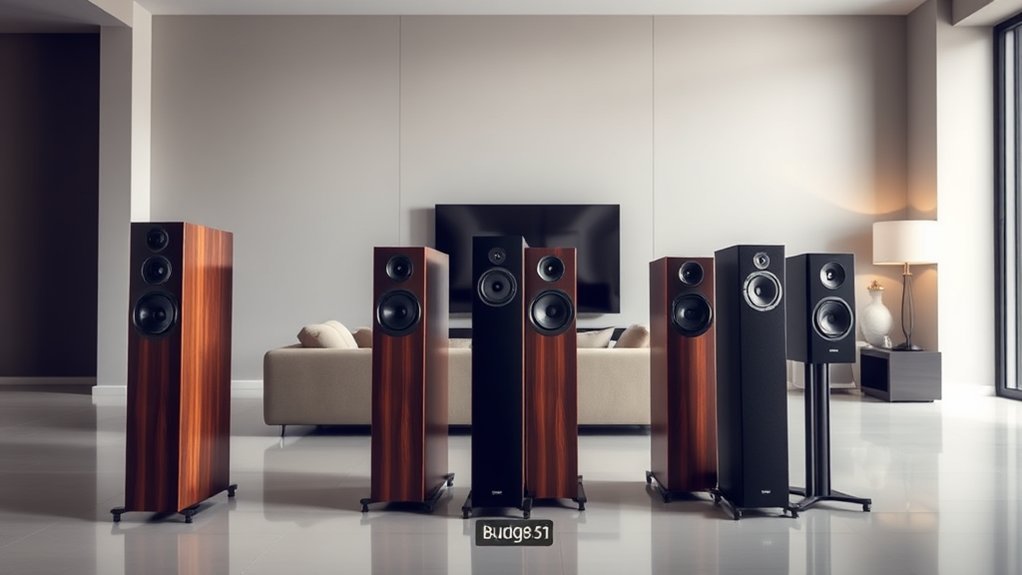
When diving into the world of floor standing home theater speakers, it’s vital to establish your budget right off the bat—think of it as setting the foundation for your audio adventure.
Floor standing speakers can range from a few hundred to several thousand dollars, and although pricier models often deliver superior sound quality, you don’t want to drain your wallet unnecessarily. Additionally, investing in a sound system with superior sound quality can enhance your overall audio experience, making it worthwhile.
Balancing cost with your expectations is key; cheaper options might skimp on bass depth or clarity. Larger cabinets typically provide richer bass and more dynamic highs compared to bookshelf speakers, so consider this when determining your budget. Additionally, keep in mind that evaluating room characteristics can significantly influence what type of speakers might work best for your space.
Tailor your budget based on how you plan to use the speakers—whether for heart-pounding movies, music immersion, or casual gaming—and factor in the cost of future amplifiers or room treatments.
After all, good sound doesn’t come cheap; but it pays off!
Assess Size and Room Compatibility
As you start to contemplate floor standing home theater speakers, it’s vital to think about size and room compatibility since that’s going to dictate not just how well your speakers sound, but also how they look in your space.
Typically, a small to medium living room, around 20 x 14 feet, matches the dimensions of these speakers, which usually stand 3 to 4 feet tall and need at least a square foot of floor space. When fitting them into your room, make sure you don’t place them too close to walls or corners, as they’ll sound boomy and muddled—nobody wants that, right? Keeping in mind that average home room sizes are around 20 x 14 feet can help you ensure your chosen speakers will suit your specific space effectively. Additionally, consider that floorstanding speakers can produce superior audio quality, adding richness and detail to your listening experience.
Prioritize Sound Performance Features
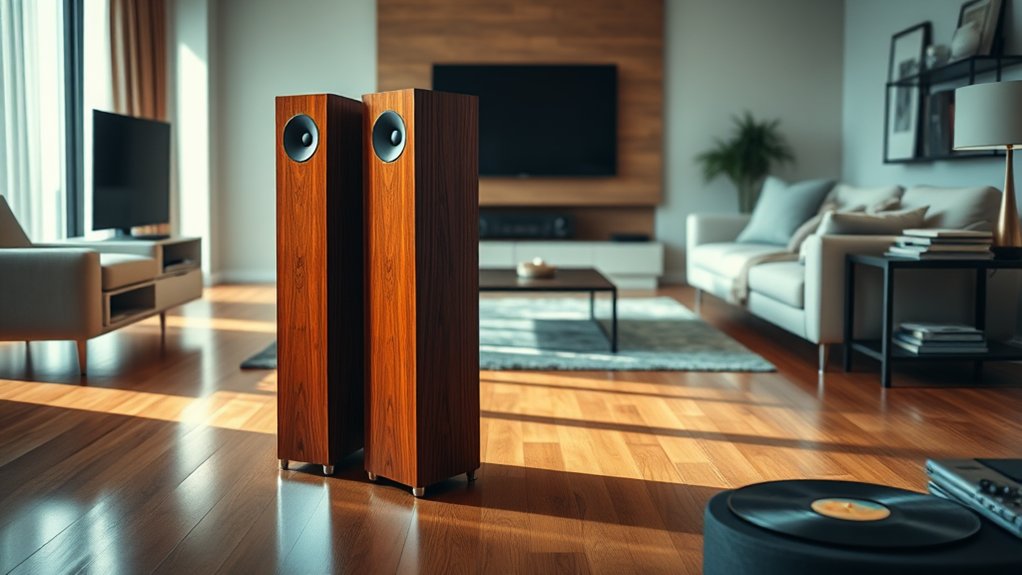
How do you guarantee that your new floor-standing speakers deliver a sound experience that truly immerses you in your favorite movies and music?
Start by prioritizing sound performance features like frequency response, ensuring it covers everything from deep bass to crisp highs—which means you won’t miss the subtle details in your favorite soundtracks. In addition, look for speakers that can decode multiple audio formats to enhance your listening experience.
Larger drivers typically offer more substantial bass, making those action scenes pop. Look for multiple driver configurations to improve sound detail, contributing to a rich auditory palette. Additionally, ensure that the speakers have high sensitivity ratings, as this will enhance sound pressure levels and improve overall audio clarity.
Moreover, consider power handling; higher ratings mean you can crank up the volume without distortion—an absolute win for thrilling movie nights!
If your speakers can create an expansive soundstage, you’ll feel the presence of music and dialogue like never before. This immersive experience is a hallmark of high-performance sound systems, making it essential for any dedicated home theater setup.
Evaluate Build Quality and Materials
Evaluating the build quality and materials of floor-standing home theater speakers is essential for ensuring you get the most out of your audio experience.
Look for cabinets made from dense materials like MDF, which reduce unwanted vibrations, enhancing sound clarity. Ideally, you want cabinets with at least 1.5-inch thickness for the front baffle and 3/4-inch for the sides. Lightweight materials? Not a chance! They just don’t cut it.
Pay attention to the driver materials too; cones crafted from treated paper or Kevlar provide durability and consistent sound.
And don’t forget the finish—high-quality laminates or wood veneers not only look great, but likewise protect your speakers from environmental wear.
After all, do you really want to hear static instead of your favorite movie’s epic soundtrack? Additionally, consider speakers with robust build quality and well-defined drivers for enhanced sound reproduction.
Ensure Amplifier Compatibility and Power Handling
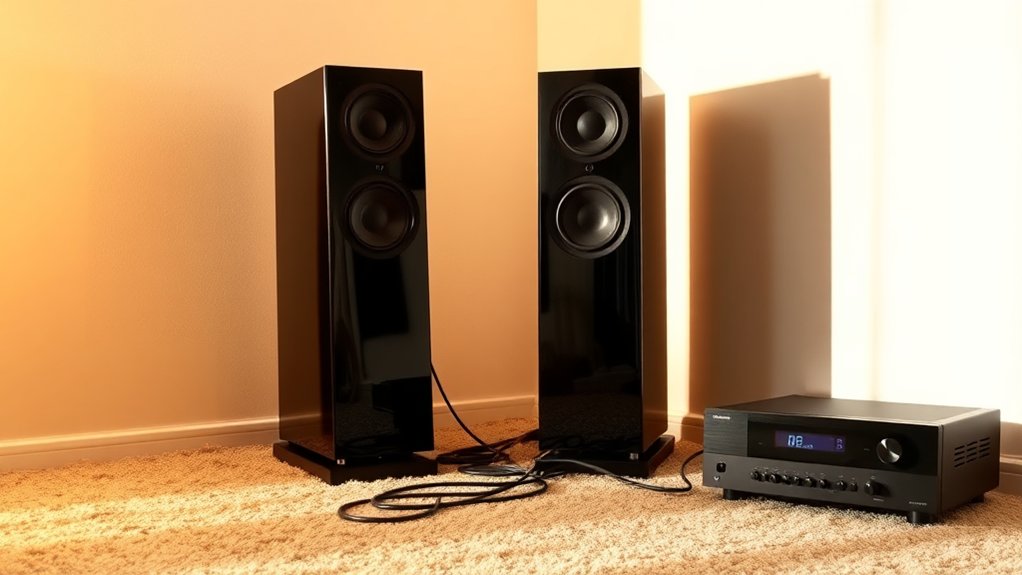
When you’re diving into the world of home theater audio, ensuring your speakers and amplifier are compatible is vital for creating that immersive sound experience you crave.
First off, check the impedance ratings of both components; matching or slightly exceeding the amplifier’s minimum impedance rating is critical—this protects your gear from unnecessary stress.
Check the impedance ratings of your speakers and amplifier to ensure compatibility and protect your equipment from undue stress.
For example, using 8Ω speakers with an 8Ω amplifier typically works well.
Next, look at power handling. Your amplifier’s wattage should align with your speakers’ maximum power handling to prevent damaging either. It’s like finding the right running shoes; too tight, and you’re in trouble.
Finally, consider the sensitivity rating of your speakers, as this influences how efficiently they convert power into sound. Additionally, features like advanced driver technology can significantly enhance your audio experience.
Happy listening!
Consider Aesthetics and Visual Integration
Aesthetics play a crucial role in creating a home theater that feels not only immersive but similarly visually pleasing to you and your guests.
When choosing floor standing speakers, consider their design and how it harmonizes with your existing decor. For instance, if you have a modern space, sleek metal finishes might be your best bet; on the other hand, wood tones could complement a more traditional setting.
Don’t forget about proportions! Tall, slim speakers can save space as they deliver sound without overwhelming the room. In addition, coordinating colors with wall paint can create a seamless vibe.
Plan for Optimal Placement and Setup
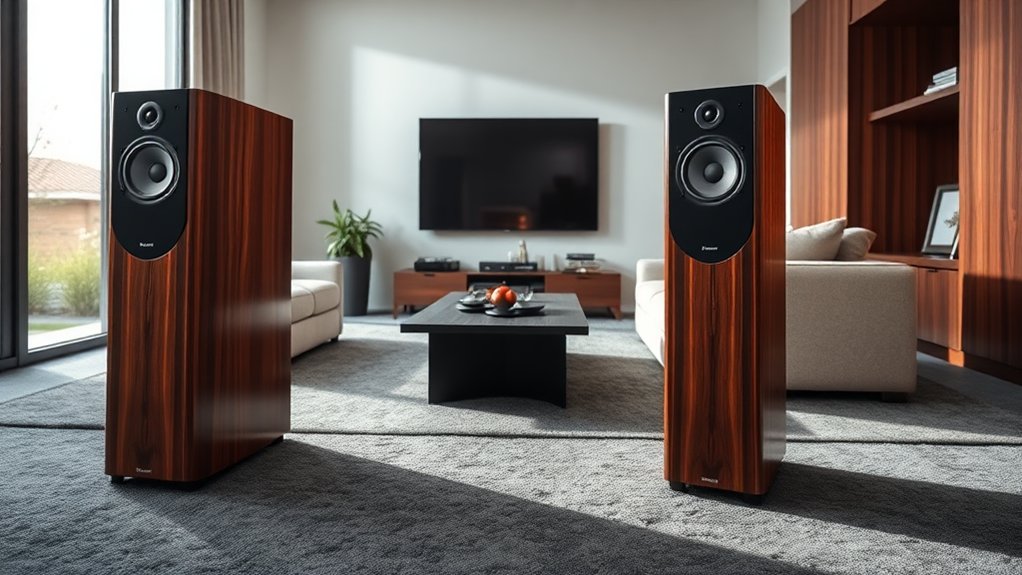
To create an exceptional home theater experience, understanding the ideal placement and setup of your floorstanding speakers is key.
Start by maintaining 1.5 to 4.5 meters (5 to 15 feet) between them, optimizing stereo imaging and soundstage width. Keep them at least 1 meter (3 feet) away from walls to reduce interference and unwanted reflections.
Just imagine that perfect sound wave, unobstructed! Position tweeters at ear level and angle the speakers slightly inward toward your listening spot, enhancing that sweet spot.
Remember, symmetry along the room’s longest wall helps balance sound.
Frequently Asked Questions
What Is the Ideal Speaker Height for Optimal Listening?
The ideal speaker height for best listening aligns the tweeter with your ear level when seated, usually around 36 to 40 inches from the floor. This guarantees clear sound imaging and improves your overall audio experience.
How Important Is the Brand Reputation When Choosing Speakers?
When choosing speakers, brand reputation’s essential. A trusted brand often means better quality and reliability, making your purchase decision easier. Plus, you’ll feel more confident knowing others have had positive experiences with that brand.
Can I Use Floorstanding Speakers for Both Music and Home Theater?
Yes, you can use floorstanding speakers for both music and home theater. They’re versatile, providing rich sound and powerful bass, enhancing your listening experience without needing separate systems. Just guarantee proper amplification and placement for peak performance.
What Are the Common Warranty Terms for Floorstanding Speakers?
Common warranty terms for floorstanding speakers usually range from 2 to 5 years. They cover defects in materials but often exclude misuse. Always check the specific terms with your selected brand or retailer.
How Do I Maintain My Floorstanding Speakers for Longevity?
To maintain your floorstanding speakers, regularly clean them using a microfiber cloth, check connections for wear, position them away from sunlight and heat, and protect finishes with covers. This guarantees lasting performance and sound quality.


